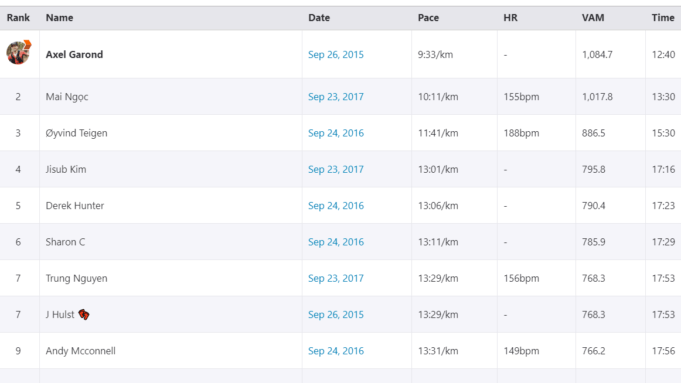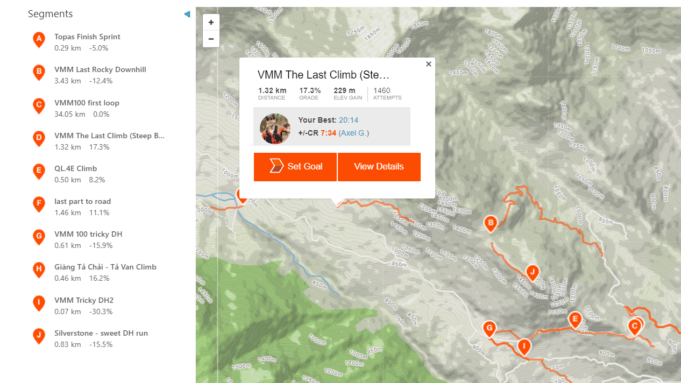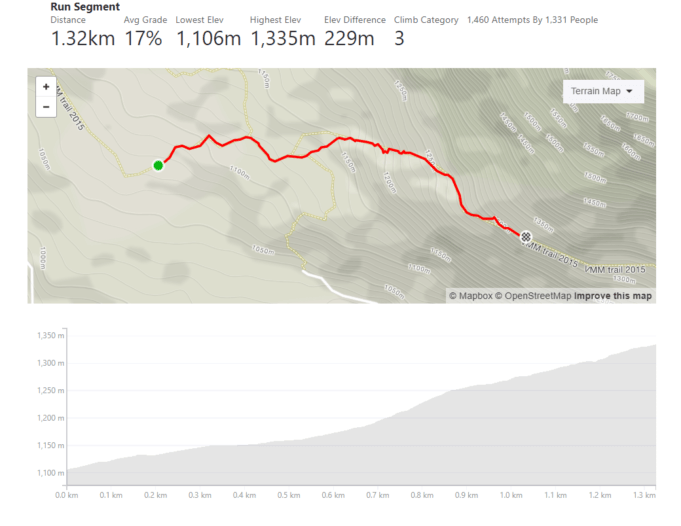Technology has made its way into running with watches that can measure many metrics. One of the most fun tools to get the most from your GPS is Strava’s segment function.
Segments are stretches of road or trail on Strava which are timed when you run them.
Each time you run a segment, your result will be recorded. If you run faster than before you will get a Personal Record (PR) – something that can be very satisfying when you are in a training period and working on your speed.

The Strava segment leaderboard for VMM’s last big climb
Three of the best segment types for trail training are uphill, downhill and mixed segments. No matter which you choose to do, you should think of them as a test of your performance, and not something you do on all your training runs.
Uphill
To go for your PR on an uphill segment you should get well warmed up before the attempt. On a short hill this will be very high intensity effort, but even on a longer incline you are going to push your limits and potentially go deep into the red.
While you can use a segment for a single, all-out attack on your PR, you can also use them for repeat/interval training – for example going 100% for your PR on your first rep, then following it with further reps to crank up the training load. Alternatively you can try multiple reps with the aim of keeping a consistently good pace on the chosen segment.


Segment Explorer
You can also use the run back down to the bottom to focus on descending form on tired legs – very useful for race day simulation.
To improve your time, add in some strength training or jumps in your normal training routine alongside your intervals.
The steeper the hill, the more strength in your legs is required. Longer, less steep hills require more endurance than strength, so try for a mix of both.
Downhill
This can be split into two different types: technical and non-technical. For both, try to run downhill as fast as possible to crack your Strava PR or go for the Course Record if you’re strong on descents.
To improve your time on a technical downhill, you should do some technique training.
A simple extension of your normal warm-up, that greatly improves your trail-technique is to do “ladder-training”. Being able to speed up your cadence is of great importance in trail running.
Non-technical downhill segments put a great load on your legs and entire body, but incorporating downhill intervals on paved/gravel roads can actually lead to better downhill running on trails, as your legs will be better prepared for a downhill beating.


Segment detail for Silverstone at VMM
Mixed segments
This type of segment should contain uphills, downhills, turns and maybe even obstacles. To get a good time you need to be good at all aspects of trail running. This also means that if you improve in one area, you should be able to do an overall better time next time you do the test.
If you put some effort into designing these segments, you can end up with a great tool for planning your future training.
By using Strava you can use the ‘compare’ function to see where you gain/lose time compared to your previous efforts, or that of your fellow runners. If you see you are losing time on the technical parts or downhills for example, you know where you need to focus your future training.
- Sign up for our Strava Club here
- Learn how to make a Strava segment here
- Learn how to get faster feet for faster segments



